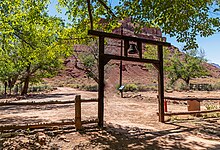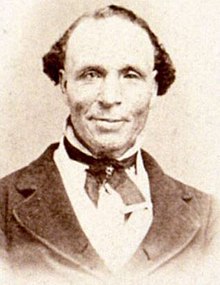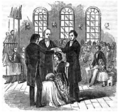|
Welcome to the portal of The Latter Day Saint movement
Introduction The Latter Day Saint movement (also called the LDS movement, LDS restorationist movement, or Smith–Rigdon movement) is the collection of independent church groups that trace their origins to a Christian Restorationist movement founded by Joseph Smith in the late 1820s. Collectively, these churches have over 17 million nominal members, including over 17 million belonging to the Church of Jesus Christ of Latter-day Saints (LDS Church), 250,000 in Community of Christ, and several other denominations with memberships generally ranging in the thousands of members. The predominant theology of the churches in the movement is Mormonism, which sees itself as restoring again on Earth the early Christian church; their members are most commonly known as Mormons, though the LDS Church now rejects the use of that name. An additional doctrine of the church allows for prophets to receive and publish modern-day revelations. A minority of Latter Day Saint adherents, such as members of Community of Christ, have been influenced by Protestant theologies while maintaining certain distinctive beliefs and practices including continuing revelation, an open canon of scripture and building temples. Other groups include the Remnant Church of Jesus Christ of Latter Day Saints, which supports lineal succession of leadership from Smith's descendants, and the more controversial Fundamentalist Church of Jesus Christ of Latter-Day Saints, which defends the practice of polygamy. (Full article...) General images -The following are images from various Latter Day Saint movement-related articles on Wikipedia.
Selected articleThe Deseret alphabet (/ˌdɛzəˈrɛt/ ; Deseret: 𐐔𐐯𐑅𐐨𐑉𐐯𐐻 or 𐐔𐐯𐑆𐐲𐑉𐐯𐐻) is a phonemic English-language spelling reform developed between 1847 and 1854 by the board of regents of the University of Deseret under the leadership of Brigham Young, the second president of the Church of Jesus Christ of Latter-day Saints (LDS Church). George D. Watt is reported to have been the most actively involved in the development of the script's novel characters, which were used to replace those of Isaac Pitman's English phonotypic alphabet. He was also the "New Alphabet's" first serious user. The script gets its name from the word deseret, a hapax legomenon in the Book of Mormon, which is said to mean "honeybee" in the only verse it is used in. The Deseret alphabet was an outgrowth of the idealism and utopianism of Young and the early LDS Church. Young and the Mormon pioneers believed "all aspects of life" were in need of reform for the imminent millennium, and the Deseret alphabet was just one of many ways in which they sought to bring about a complete "transformation in society," in anticipation of the Second Coming of Jesus. Young wrote of the reform that "it would represent every sound used in the construction of any known language; and, in fact, a step and partial return to a pure language which has been promised unto us in the latter days", which meant the pure Adamic language spoken before the Tower of Babel. (Full article...)Selected location Lees Ferry (also known as Lee's Ferry, Lee Ferry, Little Colorado Station and Saints Ferry) is a site on the Colorado River in Coconino County, Arizona in the United States, about 7.5 miles (12.1 km) southwest of Page and 9 miles (14 km) south of the Utah–Arizona state line. Due to its unique geography – the only place in hundreds of miles from which one can easily access the Colorado River from both sides – it historically served as an important river crossing and starting in the mid-19th century was the site of a ferry operated by John Doyle Lee, for whom it is named. Boat service at Lees Ferry continued for over 55 years before being superseded by a bridge in the early 20th century, which allowed for much more efficient automobile travel. (Full article...)
Selected schismatic historiesThe Church of Christ, informally referred to as the Fettingites, is a denomination within the Latter Day Saint movement which split from the Church of Christ—informally known as "Hedrickites"— in late 1929. The faction was formally established on April 8, 1930, and an Associated Press report published in The New York Times and Los Angeles Times April 7, 1930, describes it as having been briefly named "The Church of Jesus Christ" and later, the "Church of Christ". It is informally referred to as the "Church of Christ (Fettingite)", after its founder, Otto Fetting, but this sect has never officially been named as such. Otto Fetting, an Apostle in the Church of Christ, was the alleged recipient of a series of messages delivered by John the Baptist concerning construction of a temple on the Temple Lot, along with other aspects of Hedrickite doctrine and practice. The rejection of his "Twelfth Message" by a majority vote of his fellow Apostles in October 1929 led to a split in the Temple Lot organization between those who rejected Fetting's messages and those who accepted them. The "Fettingites" subsequently established their own church organization. While Fettingite doctrine and practices are virtually identical to those of the Church of Christ, a significant difference exists today in the acceptance of the messages' authenticity between Hedrickites and Fettingites. The Hedrickite leadership voted at their April, 1936 conference to formally reject Otto Fetting's claim of having heard from John the Baptist, but some laity in the Hedrickite sect have informally expressed interest or belief in his claims, to where about a half-dozen Hedrickites[who?] today believe Fetting received some or all of the revelations he claimed. After its founder's death in 1933, the Fettingite sect further divided into various factions, including The Church of Christ (Restored), the Church of Christ at Halley's Bluff, and the Church of Christ with the Elijah Message. As with the Church of Christ, each of these groups declares itself to be the "only true and living church upon the face of the whole earth." (Full article...)OutlinesRelated portalsKey biographies Selected image Title page of the original 1830 copy of The Book of Mormon: An Account Written by the Hand of Mormon upon Plates Taken from the Plates of Nephi
Did you know (auto generated)
Selected Anniversaries
Selected quote
TopicsFeatured contentCategoriesWikiProjectsAssociated WikimediaThe following Wikimedia Foundation sister projects provide more on this subject:
Discover Wikipedia using portals | ||||||||





































